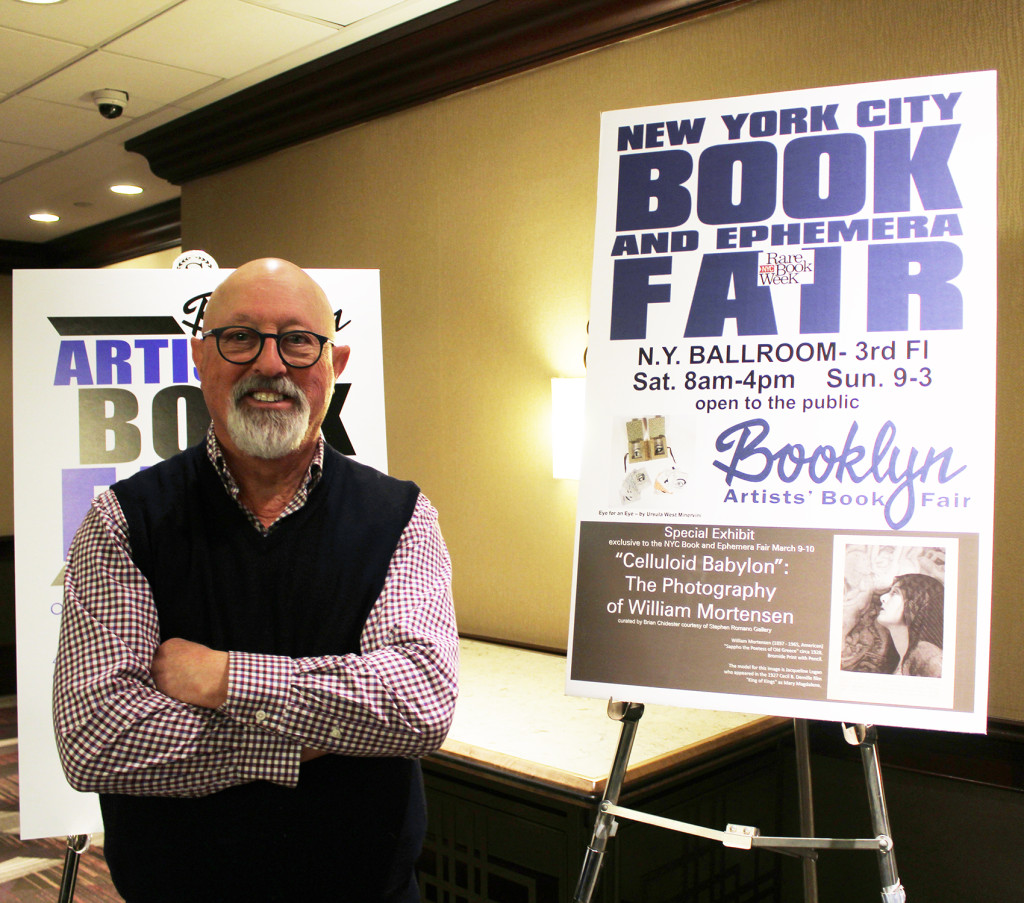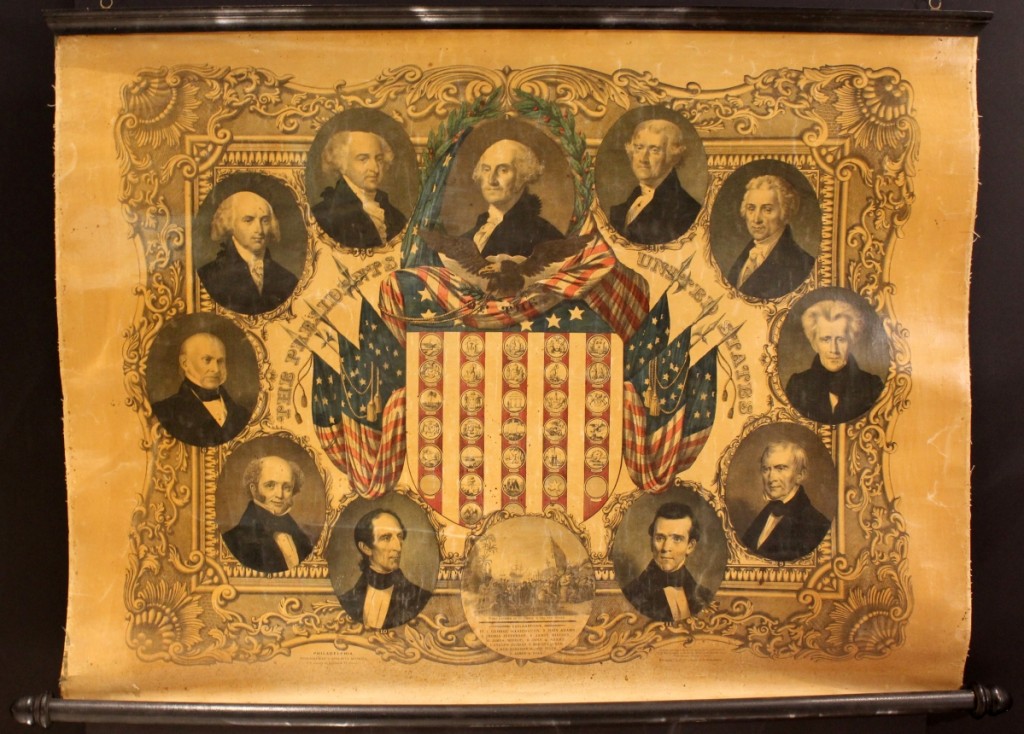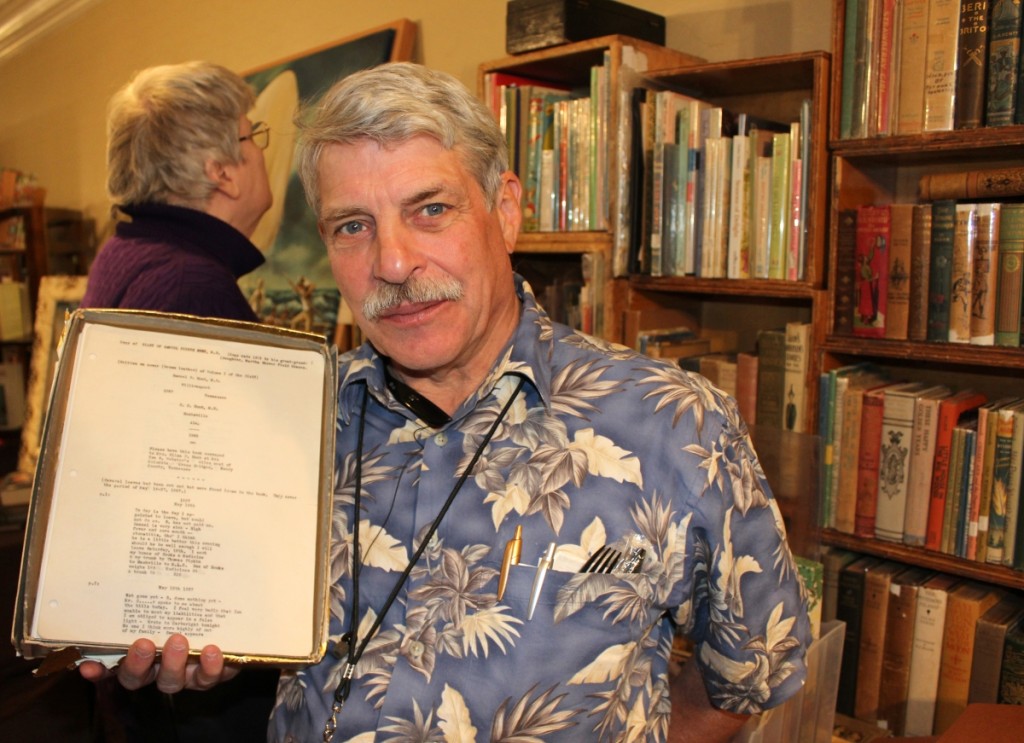
Marvin Getman, show manager, said his inaugural addition of a book artists section to his book and ephemera fair was “tremendously successful,” adding, “It’s something I’ve wanted to do for a long time.”
Review and Photos by W.A. Demers
NEW YORK CITY – Marvin Getman, promoter of the satellite event occurring during Manhattan’s Rare Book Week, had great news for bibliophiles and ephemera collectors. What had been a one-day affair at the Sheraton Central Park/Times Square hotel, was not only coming back for its fifth edition on March 9 but was adding an extra day – Sunday, March 10, to give shoppers more time to make their “finds.”
The New York City Book & Ephemera Fair had another ace up its sleeve. “It’s something I’ve wanted to do for a long time,” said Getman, referring to the addition of a book artists section, the first annual Booklyn Artists’ Book Fair (BABF) – a special section devoted to contemporary artists’ books. A fair-within-a-fair, the section was curated and organized by Marshall Weber, co-founder of Booklyn, an artist-run nonprofit organization based in Brooklyn. So in addition to his usual stable of about 60 traditional rare book and ephemera dealers, Getman’s event featured more than 40 tables of work by member artists and artists’ groups.
This fair also presented a special exhibition. “The Celluloid Babylon,” mounted in an exclusive space off the ballroom floor featured photography by artist William Mortensen, whose controversial images launched a whole new photographic movement in the 1930s-1940s. It was curated by author/art historian Brian Chidester and comprised about 80 photos from the collection of the Stephen Romano Gallery. The focus was on Mortensen’s years when he worked as a costume designer on the Cecile B. DeMille’s epic film The King of Kings and highlights the golden years when stars such as Faye Wray, Jean Harlow, John Barrymore and Rudolph Barrymore were Mortensen’s photographic subjects.
Recalled the exhibition’s curator Chidester, “I met Marvin a few years back, and in the aftermath I have been discussing creative ways of integrating his antiquarian book/ephemera fairs with talks and exhibitions that enrich the program for attendees. He asked me if I had an idea for a more immediate exhibition for his NYC Book and Paper Fair and I suggested William Mortensen’s photographs because I liked the idea of breaking down the walls between art and design and between mass-produced and one-of-a-kind objects. Artists have always had to toggle those two worlds, in fact, and still do today, and it’s actually sort of a hidden secret of the gallery and museum world that all these artists they represent have to have second jobs, second lives really, in order to survive.”
Among the show’s rare book and ephemera dealers, shoppers could find all manner of first editions, beloved classics, rare books, autographed historical documents, vintage photography, old maps and more.

At Original Antique Maps, Framingham, Mass., “Portraits of the Presidents of the United States,” 1846, by Peter S. Duval.
From Philadelphia, Zoe Abrams Rare Books made an early sale of a Femmes Prisionniéres poster, listing more than 600 women imprisoned at Versailles after their failed march there following Napoleon III’s surrender to Otto von Bismarck in the Franco-Prussian War. Included were the ages of the women who marched, the oldest being over 70. “I loved not only the way it looked on my wall, but also what it signified, and many dealers especially seemed to agree,” said Abrams. “The show was very busy Saturday and very slow Sunday. I think most exhibitors did the majority of their buying and selling at setup, and most clients did their buying at the opening early Saturday morning, as usually happens at fairs. It’s always a thrill to see a line forming outside the door, and to witness the rush when the guards step aside – Bibliomania!”
Abrams added that she had a number of items sold or placed on hold from her fair list, which she had sent out the previous Tuesday. “The things that went quickly from my list and booth were the unique items, for instance, a mysterious religious manuscript with interleaved engravings – a hybrid book combining print and mostly manuscript elements – for which I had multiple orders. It was presented as if it were a printed book, but I can only speculate at its purpose: a mock-up for print? A private devotional exercise? A gift? I never found a record of the title in print; however, I did find another devotional book with a similar title in multiple Seventeenth and Eighteenth Century editions. Could mine have been a play on that title?”
“This was the best of Marvin’s NYC Book and Ephemera Fairs so far; serious collectors, institutional representatives – libraries and museums – and dealers from the New York International Antiquarian Book Fair were the first through the doors early Saturday morning,” said Adrienne Horowitz Kitts of Austin Abbey Rare Books, Mount Vernon, Va. “Our first purchase of the day happened literally two minutes after the doors opened, when a dealer purchased a set of Eighteenth Century American silk and watercolor embroidered panels from us. After that sales were fast and steady throughout the rest of the day to all three customer groups. Many of my collector customers told me that they particularly enjoyed this fair since they could actually afford to purchase books. Although Sunday was a bit quieter than Saturday, the stream of visitors was steady throughout the afternoon. The wonderful selection of varied dealers, book artists and the photograph exhibit were a wonderful draw for the fair, and Marvin worked tirelessly to insure a big turnout.”
Getman told Antiques and The Arts Weekly that when he offered the space in his show to the Booklyn group, they jumped on it. “The rare book dealers enjoyed talking with the young artists,” he said. And while books by well-known artists are prized by museums, libraries and educational institutions, the increase in awareness of artists’ books has been spurred by a new generation of cutting-edge young artists, working in a variety of media – aquatint, collage, fine letterpress, hand painted, photo-art, screen prints and risograph. They produce unique books that not only express their own vision, but communicate ideas that are of timely concern.
Richard Turnbull is one such artist experimenting with innovative letterpress and encaustic techniques with his Furious Day Press. “There was definitely interest in my work – more so on Sunday, for some reason,” he said. “A book artist visiting from Mexico bought one of my experimental letterpress books, as did an independent curator from Brooklyn. Also, Swarthmore University Libraries purchased one of my encaustic books. I was told by one of the Booklyn coordinators that more and more these kinds of artists’ book fairs are dominated by institutional rather than private collectors, a trend I have also noticed over the last few years. It may be that there has yet to develop a new, younger group of artists’ book collectors.”

Richard Mori of Franklin, N.H., is a well-known source of material for rare book hounds and recently purchased the Granite State Book and Ephemera Fair, which is set for June 2 in Concord, N.H. Here he holds the 1887 diary of a Tennessee homeopathic doctor, Samuel Pierre Hunt, who served in an Alabama regiment during the Civil War. It was transcribed by the doctor’s granddaughter in 1952.
Also synthesizing a whole new category of book is Philadelphia artist Colette Fu, who makes one-of-a-kind artist’s books that combine photography and pop-up paper engineering. An example was “Luoma, Yi Tiger Festival,” documenting the Yi people from China’s Yunan province as they worship the tiger, offering sacrifice and dance to reflect their way of life. Not only does Fu travel to exotic locales for the photography and engineer the books’ construction, she also hand crafts the bindings, as in the case of an example depicting an Inner Mongolia men’s wrestling competition, which she covered in black leather.
A third example was Aaron Sinift, whose project “5-Year Plan” literally was a five-year endeavor to help support artists as well as artisans in India. Soliciting public subscriptions, Sinift sourced all materials and fabrication for a textile book from India. Made of 1,400 meters of homespun cloth, printed and bound there, the book features screen- and block-printed artworks by 24 artists from eight countries. He commissioned well-known artists like Francesco Clemente, Yoko Ono, Chris Martin, Jenny Holzer and others. “The only ‘gringo’ in the whole operation was me,” he proudly stated. From profits, he raised $5,000 for Doctors Without Borders, and says 20 copies remain.
For additional information, www.bookandpaperfairs.com or 781-862-4039.











.jpg)














